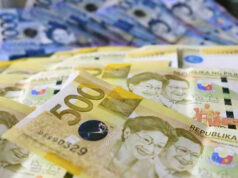THE PESO will likely trade stronger against the dollar this week after investors were disappointed by the inauguration speech of US President Donald J. Trump, also buoyed by bets of upbeat Philippine economic growth for the last quarter of 2016.
The peso closed at P49.92 versus the foreign unit on Friday, six centavos higher compared to its finish of P49.98 per dollar the previous session. Week on week, the local unit fell 28 centavos from its P49.64 close last Jan. 13.
Traders said that the peso’s movement will depend on the outcome of Mr. Trump’s speech, particularly if his remarks would meet market’s expectations that he would give clarity on his fiscal reforms for the US economy.
“[This week] we will wait for the actual statements of Trump so we will check the movements of the dollar over the weekend… If he’s dollar supportive, then there will be a definitive break of the P50 and we will see the pair ahead of P50.50, but once Trump talks of a dollar down, then we might see the pair to test around P49.70 or P49.64 as the last low,” the trader said ahead of the inauguration last Friday.
“It’s primarily dependent on Trump’s statement [on Friday night.] His statement will really set the direction of the dollar ahead of the FOMC (Federal Open Market Committee) meeting in early February,” the trader said.
Similarly, another trader said by phone: “Everyone’s just waiting for Trump’s inauguration.”
In his inauguration speech after local markets closed on Friday, Mr. Trump disappointed market players as he still failed to provide further details on his fiscal plans for the US economy. Instead, the 45th president of the US only focused on his nationalist vow to put “America first” in his speech.
Guian Angelo S. Dumalagan, market economist at the Land Bank of the Philippines (Landbank), said in his weekly outlook: “The dollar might depreciate this week, as the relatively balanced inaugural speech of US President Donald Trump upset some investors who were expecting even more clarity about his campaign promises of lower taxes and higher infrastructure spending.”
Mr. Dumalagan noted that Mr. Trump’s “America first” thrust may have negative implications on global trade as it may drag the dollar down on questions about the plan’s sustainability.
“Mixed US economic data might not be able to save the dollar from weakening, as they could unlikely overshadow perceptions of heightened policy uncertainty in the world’s largest economy,” he added.
Mr. Dumalagan was referring to bets of upbeat US data on manufacturing and existing home sales that may divert market players’ attention towards robust US economic fundamentals “and reduce the emotional influence of President Trump’s inaugural address.”
Meanwhile, Mr. Dumalagan noted that the dollar could reverse its expected depreciation against the peso this week should data on Philippine economic growth in the fourth quarter and 2016 come out softer than expected.
However, should the gross domestic product (GDP) data be upbeat and fall within the government’s 6-7% target band, then the greenback might drop further against the local unit, he said.
“Decent growth in 2016 might reinforce views that the Philippines would continue to surge this year on the back of strong domestic demand and likely higher infrastructure spending by the Duterte administration.”
The government is confident that it met its target of a 6-7% GDP growth for 2016 after the economy’s expansion clocked in at 7% in the first nine months of last year.
For his part, BDO Unibank, Inc.’s Chief Market Strategist Jonathan L. Ravelas said the peso may move within P49.60 to P50 range, with the P50-a-dollar level still expected to be “a strong resistance.” Meanwhile, one trader said that the peso may range within P49.60 to P50.20 to the dollar and Landbank’s Mr. Dumalagan sees the local unit falling between the P49.70 to P50 range. — Janine Marie D. Soliman



